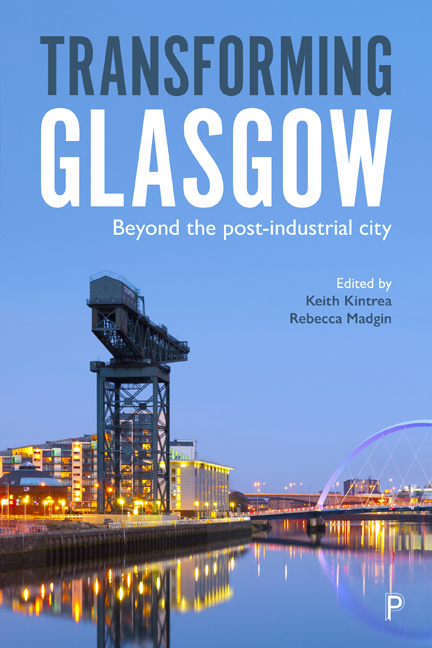Book contents
- Frontmatter
- Contents
- List of Maps, Tables, Figures and Boxes
- Notes on Contributors
- Acknowledgements
- Foreword
- Map
- Introduction: Transforming Post-Industrial Glasgow – Moving Beyond the Epic and the Toxic
- PART I
- PART II
- PART III
- Conclusion: Beyond the Post-Industrial – Narratives of Time and Place
- Index
5 - Living in the Urban Renaissance? Opportunity and Challenge for 21st-Century Glasgow
Published online by Cambridge University Press: 25 March 2021
- Frontmatter
- Contents
- List of Maps, Tables, Figures and Boxes
- Notes on Contributors
- Acknowledgements
- Foreword
- Map
- Introduction: Transforming Post-Industrial Glasgow – Moving Beyond the Epic and the Toxic
- PART I
- PART II
- PART III
- Conclusion: Beyond the Post-Industrial – Narratives of Time and Place
- Index
Summary
Introduction
Promoted as ‘one of the best examples of urban regeneration in existence’, Glasgow presents a confident face to the world. However, this bold statement of success belies the more complex reality of life in the 21st-century city. This chapter explores the rebirth of Glasgow as a desirable urban centre, while questioning the extent to which this success might obscure a more textured picture of winners and losers in the changing city. The latter half of the 20th century brought a reversal of fortune to Glasgow, leaving swathes of derelict post-industrial land and urban depopulation. As with many cities in Europe, the United States and beyond, more affluent people left the city with poorer citizens from working class suffering from stigmatisation (Harvey, 1996; Hothi, 2005; High et al, 2017). Although, historically, poverty has been focussed in inner cities, surrounded by relatively wealthy suburbs, there are indications of a shift in this pattern across the affluent world, including cities in Australia, the US and more recently in the UK (Kneebone and Berube, 2013, Hunter, 2014, Pawson et al, 2015). There is evidence that greater urban densification may have positive social and economic benefits (Rodriguez-Pose, 2018). However, the picture is not straightforward: countries that exhibit increases in urban concentration also show increasing levels of inequality (Castells-Quintana and Royuela, 2015).
It is against this backdrop that we examine Glasgow in the 21st century, as it grapples with the challenge of economic transition. Globalisation has required a new agility from municipal authorities, as they strive to attract investment, new visitors and new citizens (Wise and Clark, 2017). While efforts to revitalise the city and mitigate the disadvantages faced by some inhabitants have been predominantly portrayed as positive, regeneration strategies can easily serve as gentrifying forces, marginalising or displacing those that they were intended to benefit (Marcuse, 1985). There are considerable tensions involved in maximising economic growth at the same time as supporting social and environmental goals (Couch et al, 2011). We begin by considering Glasgow in relation to aspirations for urban renaissance, offering a thumbnail sketch of the city's urban structure.
- Type
- Chapter
- Information
- Transforming GlasgowBeyond the Post-Industrial City, pp. 101 - 120Publisher: Bristol University PressPrint publication year: 2019

